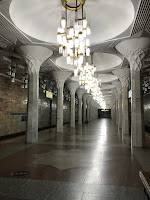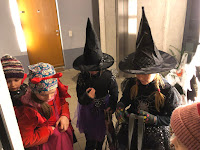 Well my Uzbekistan adventure came to a close. I can't believe that I finally made it there. It's the item that's been on my bucket list the longest but after 32 years I did it.
Well my Uzbekistan adventure came to a close. I can't believe that I finally made it there. It's the item that's been on my bucket list the longest but after 32 years I did it.
I also had my first Aeroflot flight and made it to Moscow. Only as far as my "capsule" hotel in transit hall at Sheremetyevo Airport.
 I started off in Tashkent. It reminded me of other former Soviet cities with the way things were laid out. There was plenty to see but it didn't have the rich history of the other cities I visited.
I started off in Tashkent. It reminded me of other former Soviet cities with the way things were laid out. There was plenty to see but it didn't have the rich history of the other cities I visited.
 I'm glad that I took the half-day trip out to the mountains and Lake Charvak.
I'm glad that I took the half-day trip out to the mountains and Lake Charvak.
 One thing worth checking out is the Tashkent metro. Many of the stations are simply stunning.
One thing worth checking out is the Tashkent metro. Many of the stations are simply stunning.
 One of my friends knows a guy who works at one of the embassies in Tashkent, who he put me in touch with. On my last night in Tashkent he invited me over to have some wine and to meet his boyfriend. It was a lovely evening. I would post a photo and use names but I can't because being gay is illegal and can be punished by a three to five year prison sentence. It was still one of the highlights of my trip.
One of my friends knows a guy who works at one of the embassies in Tashkent, who he put me in touch with. On my last night in Tashkent he invited me over to have some wine and to meet his boyfriend. It was a lovely evening. I would post a photo and use names but I can't because being gay is illegal and can be punished by a three to five year prison sentence. It was still one of the highlights of my trip.
 I then caught the train to Samarkand. My Russian failed me a bit here because instead of getting on the high-speed train I ended up on the normal Uzbek railway. Overall not bad and I got some extra time to relax with my book.
I then caught the train to Samarkand. My Russian failed me a bit here because instead of getting on the high-speed train I ended up on the normal Uzbek railway. Overall not bad and I got some extra time to relax with my book.
 Samarkand was small but so much to see. In one day I walked 20 km (12,5 mile) walk where I visited mosques, museums, a souq, an ancient observatory, a necropolis, Jewish, Christian, and Muslim cemeteries, and the tomb of St. Daniel.
Samarkand was small but so much to see. In one day I walked 20 km (12,5 mile) walk where I visited mosques, museums, a souq, an ancient observatory, a necropolis, Jewish, Christian, and Muslim cemeteries, and the tomb of St. Daniel.
This photo of Registan is for sure going up on Facebook.

 For anyone going to Uzbekistan I can't stress this enough. Bring either U.S. Dollars or Euros with you to exchange. Very few places take cards so you need to have cash on you. Most of the ATMs across the country don't work with foreign cards. Some machines only work with Visa while some only work with MasterCard. And it was very common for ATMs simply to be out of cash.
For anyone going to Uzbekistan I can't stress this enough. Bring either U.S. Dollars or Euros with you to exchange. Very few places take cards so you need to have cash on you. Most of the ATMs across the country don't work with foreign cards. Some machines only work with Visa while some only work with MasterCard. And it was very common for ATMs simply to be out of cash.
 Use the ATM at the airport when you land and take out more money than you normally would. When I first landed I only took out 1,5 million Uzbek Som (€145 or $159). I should have taken out enough money for the entire trip because trying to get more cash later was a bit of an adventure.
Use the ATM at the airport when you land and take out more money than you normally would. When I first landed I only took out 1,5 million Uzbek Som (€145 or $159). I should have taken out enough money for the entire trip because trying to get more cash later was a bit of an adventure.

After a couple of days in Samarkand it was another train ride to
Bukhara. There is so much history to explore in Bukhara. You can't turn a corner without coming across an ancient mosque, madrasa, mausoleum.

Things only get more beautiful at night when the lights come on.
After a week my Russian was pretty functional again. An Uzbek woman said that I spoke pretty decent Russian for a Czech. Not sure how I felt about this because the joke goes that when a drunk Czech speaks Russian what you end up with is Slovak.

The food was really good and cheap. Lots of shashlik which are basically shish kebab. The Plov (national rice pilaf dish) was excellent.

Dinner one night in Bukhara was black tea, break, meat soup and meat dumplings for 36.000 Som (€3,47 or $3.82).
If I had a few more days in Uzbekistan then I would have made it up ti Khiva. Since I didn't make it this time I guess a return visit is in order. Hopefully it won't take 32 years to make it back again.
 From Tashkent I had my first flight with S7 (Siberian Airlines) which is part of Oneworld Alliance. Unfortunately there was some mechanical problems with the connecting flight in Moscow so I was delayed a couple of hours getting back to Vienna on Sunday night.
From Tashkent I had my first flight with S7 (Siberian Airlines) which is part of Oneworld Alliance. Unfortunately there was some mechanical problems with the connecting flight in Moscow so I was delayed a couple of hours getting back to Vienna on Sunday night.

Overall a great trip! Now the only
Central Asian countries still to visit are Tajikistan and Turkmenistan.
Hmmm....maybe in 2020.






 The second, and probably biggest problem with Halloween is that 31 October is Reformationstag (Reformation Day) which celebrates Martin Luther's Protestant Reformation that split the Catholic Church. It's an important day for Lutherans and it is an official religious holiday in the German states of Brandenburg, Mecklenburg-Vorpommern, Saxony, Saxony-Anhalt, and Thuringia. All the states that used to make up East Germany.
The second, and probably biggest problem with Halloween is that 31 October is Reformationstag (Reformation Day) which celebrates Martin Luther's Protestant Reformation that split the Catholic Church. It's an important day for Lutherans and it is an official religious holiday in the German states of Brandenburg, Mecklenburg-Vorpommern, Saxony, Saxony-Anhalt, and Thuringia. All the states that used to make up East Germany.



























































































